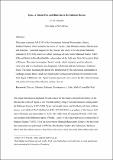Files in this item
‘Iyani, a Shirazi poet and historian in the Bahmani Deccan
Item metadata
| dc.contributor.author | Peacock, A.C.S. | |
| dc.date.accessioned | 2022-12-20T00:40:59Z | |
| dc.date.available | 2022-12-20T00:40:59Z | |
| dc.date.issued | 2021-07-20 | |
| dc.identifier | 273574719 | |
| dc.identifier | f3406a51-6e69-43b3-b39b-14a236795669 | |
| dc.identifier | 85108251291 | |
| dc.identifier | 000664571000003 | |
| dc.identifier.citation | Peacock , A C S 2021 , ' ‘Iyani, a Shirazi poet and historian in the Bahmani Deccan ' , Iran: Journal of British Institute of Persian Studies , vol. 59 , no. 2 , pp. 169-186 . https://doi.org/10.1080/05786967.2021.1911758 | en |
| dc.identifier.issn | 0578-6967 | |
| dc.identifier.uri | https://hdl.handle.net/10023/26625 | |
| dc.description.abstract | This paper examines MS D. 92 of the Government Oriental Manuscripts Library, Madras/Chennai, which contains the works of ‘Iyani, a late fifteenth century Shirazi poet and historian. ‘Iyani had migrated to the Deccan, and wrote in Persian in the Bahmani sultanate (1347–1528), receiving the patronage of both Sultan Mahmud Shah (r. 1482–924) and Habib al-Din Muhibballah, a descendant of the Sufi saint Shah Ni‘matallah Vali of Kirman. The paper investigates ‘Iyani’s works, which comprise qasidas, ghazals, ruba‘iyyat and two mathnavīs, the Jangnama-i Shahrukh and the Fathnama-i Mahmud Shahi. The latter, recording the defeat of a rebellion led by the Abyssinian commander in Gulbarga, Dastur Dinar, sheds new light on the political and factional environment in the final stages of Bahmani rule. ‘Iyani’s works represent a new source for the cultural, literary and political history of the fifteenth century Deccan. | |
| dc.format.extent | 614858 | |
| dc.language.iso | eng | |
| dc.relation.ispartof | Iran: Journal of British Institute of Persian Studies | en |
| dc.subject | Deccan | en |
| dc.subject | Bahmani Sultanate | en |
| dc.subject | Persian poetry | en |
| dc.subject | Bidar | en |
| dc.subject | Shah Ni'matallah Wali | en |
| dc.subject | D111 Medieval History | en |
| dc.subject | PK Indo-Iranian | en |
| dc.subject | T-NDAS | en |
| dc.subject.lcc | D111 | en |
| dc.subject.lcc | PK | en |
| dc.title | ‘Iyani, a Shirazi poet and historian in the Bahmani Deccan | en |
| dc.type | Journal article | en |
| dc.contributor.institution | University of St Andrews. Centre for Late Antique Studies | en |
| dc.contributor.institution | University of St Andrews. St Andrews Institute of Medieval Studies | en |
| dc.contributor.institution | University of St Andrews. School of History | en |
| dc.identifier.doi | https://doi.org/10.1080/05786967.2021.1911758 | |
| dc.description.status | Peer reviewed | en |
| dc.date.embargoedUntil | 2022-12-20 |
This item appears in the following Collection(s)
Items in the St Andrews Research Repository are protected by copyright, with all rights reserved, unless otherwise indicated.

